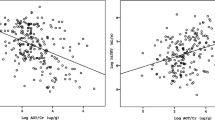Abstract
Purpose
Autosomal dominant polycystic kidney disease (ADPKD) is the most common genetic kidney disease and the majority of patients have a PKD-1 or PKD-2 mutation. Sirtuin 1 (SIRT1) has roles in cellular aging, antioxidant activity, cellular proliferation. In an experimental study, inhibition of SIRT1 was found to delay renal cyst development in ADPKD. The purpose of this study is to determine the SIRT1 levels in ADPKD patients. To our knowledge, this is the first study that investigating blood and urine SIRT1 levels in ADPKD patients.
Methods
Sixty-seven patients with ADPKD and 34 control cases with normal renal functions and without renal cysts were included in this study. Serum and urine SIRT1 concentrations were determined by human enzyme-linked immunosorbent assay (ELISA) kit. 24-h urine samples were used for urine SIRT1 measurements.
Results
The urine SIRT1 levels were statistically significantly lower in ADPKD patients group (p < 0.001). Although blood SIRT1 levels of ADPKD patients were higher than control cases but there were no statistically significant difference between the groups in terms of blood SIRT1 levels. Urine SIRT1 levels (β = 2.452, CI 95% 1.419–4.239, p = 0.001) were found an independent factor in multivariate regression analysis for ADPKD.
Conclusions
Urine SIRT1 levels were lower in ADPKD patients than control group. The low urinary SIRT1 levels despite the similar blood SIRT1 levels might be due to the impaired metabolism of SIRT1 in ADPKD patients; this state might has a role in cyst development.
Similar content being viewed by others
References
Grantham JJ (2008) Clinical practice. Autosomal dominant polycystic kidney disease. N Engl J Med 359:1477–1485
Ters ME, Zhou X, Lepping RJ, Lu P, Karcher RT, Mahnken JD et al (2020) Biological efficacy and safety of niacinamide in patients with ADPKD. Kidney Int Rep 5:1271–1279
Morigi M, Perico L, Benigni A (2018) Sirtuins in renal health and disease. J Am Soc Nephrol 29:1799–1809
Haigis MC, Guarente LP (2006) Mammalian sirtuins emerging roles in physiology, aging, and calorie restriction. Genes Dev 20:2913–2921
Dong YJ, Liu N, Xiao Z et al (2014) Renal protective effect of Sirtuin 1. J Diabetes Res. https://doi.org/10.1155/2014/843786
Rule AD, Amer H, Cornell LD, Taler SJ, Cosio FG, Kremers WK et al (2010) The association between age and nephrosclerosis on renal biopsy among healthy adults. Ann Intern Med 152:561–567
Hsu CY, Iribarren C, McCulloch CE, Darbinian J, Go AS (2009) Risk factors for end-stage renal disease: 25-year follow-up. Arch Intern Med 169:342–350
Fontana L, Partridge L, Longo VD (2010) Extending healthy life span: from yeast to humans. Science 328:321–326
Guclu A, Erdur FM, Turkmen K (2016) The emerging role os sirtuin 1 in cellular metabolism, diabetes mellitus, diabetic kidney disease and hypertension. Exp Clin Endocrinol Diabetes 124:131–139
Turkmen K, Karagoz A, Kucuk A (2014) Sirtuins as novel players in the pathogenesis of diabetes mellitus. World J Diabetes 5:894–900
Zhou X, Fan LX, Sweeney WEJR et al (2013) Sirtuin 1 inhibition delays cyst formation in autosomal-dominant polycystic kidney disease. J Clin Invest 123:3084–3098
Ravine D, Gibson RN, Walker RG et al (1994) Evaluation of ultrasonographic diagnostic criteria for autosomal dominant polycystic kidney disease 1. Lancet 343:824–827
Peintner L, Borner C (2017) Role of apoptosis in the development of autosomal dominant polycystic kidney disease (ADPKD). Cell Tissue Res. https://doi.org/10.1007/s00441-017-2628-6
Persu A, Duyme M, Pirson Y et al (2004) Comparison between siblings and twins supports a role for modifier genes in ADPKD. Kidney Int 66:2132–2136
Irazabal MV, Torres VE (2013) Experimental therapies and ongoing clinical trials to slow down progression of ADPKD. Curr Hypertens Rev 9:44–59
Woo D (1995) Apoptosis and loss of renal tissue in polycystic kidney diseases. N Engl J Med 333:18–25
Evan GI, Wyllie AH, Gilbert CS et al (1992) Induction of apoptosis in fibroblasts by c-Myc protein. Cell 69:119–128
Fan LX, Zhou X, Sweeney WE et al (2013) Smac-mimetic-induced epithelial cell death reduces the growth of renal cysts. J Am Soc Nephrol 24:2010–2022
Trudel M, Lanoix J, Barisoni L et al (1997) C-myc–induced apoptosis in polycystic kidney disease is Bcl-2 and p53 independent. J Exp Med 186:1873–1884
Edelstein CL (2005) What is the role of tubular epithelial cell apoptosis in polycystic kidney disease (PKD)? Cell Cycle 4:1550–1554
Goilav B (2011) Apoptosis in polycystic kidney disease. Biochim Biophys Acta 1812:1272–1280
Wilson PD (2004) Polycystic kidney disease: new understanding in the pathogenesis. Int J Biochem Cell B 36:1868–1873
Adlouni AA, Hertig A (2014) Vitamin B3 to prevent autosomal dominant polycystic kidney disease. Nephrol Ther 10:183–185. https://doi.org/10.1016/j.nephro.2013.11.009
Funding
None.
Author information
Authors and Affiliations
Corresponding author
Ethics declarations
Ethical approvement
All procedures performed in studies involving human participants were in accordance with the ethical standards of the institutional and/or national research committee at which the studies were conducted and with the 1964 Helsinki declaration and its later amendments or comparable ethical standards. The study was accepted (Decision number 41901325-050.99) by the Ethics Committee of Karatay University. Signed informed consent form was taken from all patients and control cases.
Conflict of interest
The authors declare that they have no conflict of interest.
Informed consent
Informed consent was obtained from all individual participants included in the study.
Additional information
Publisher's Note
Springer Nature remains neutral with regard to jurisdictional claims in published maps and institutional affiliations.
Rights and permissions
About this article
Cite this article
Ozkan Kurtgoz, P., Karakose, S., Cetinkaya, C.D. et al. Evaluation of sirtuin 1 (SIRT1) levels in autosomal dominant polycystic kidney disease. Int Urol Nephrol 54, 131–135 (2022). https://doi.org/10.1007/s11255-021-02862-2
Received:
Accepted:
Published:
Issue Date:
DOI: https://doi.org/10.1007/s11255-021-02862-2




